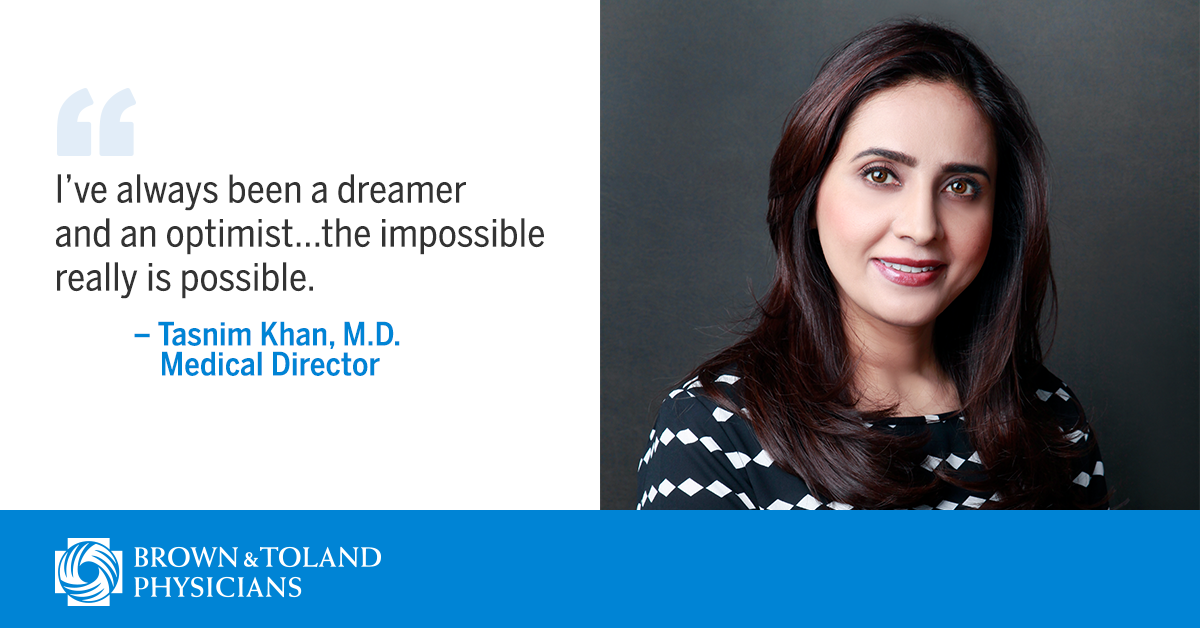Tasnim Khan, MD: A life of lessons learned…and still learning

Meet Dr. Tasnim Khan, who recently joined Brown & Toland Physicians as medical director. A Harvard-trained physician executive with more than 25 years of medical management experience, Dr. Khan is a passionate advocate for physician wellbeing and social justice in health care.

In addition to her new role, she is completing the certificate program at Stanford University’s WellMD Center, which helps medical professionals take steps to improve their own wellbeing and fulfillment so they can provide better care for patients. She is also a second-year fellow in the California Health Care Foundation Leaders Fellowship, where her focus is on innovation in chronic care management, advocacy/policy and social circumstances, health equity and clinical quality.
How did you decide to become a physician?
I had always dreamed of being a physician but thought it was impossible and I didn’t have a role model to lead the way. As someone who emigrated to the United States at age 15, I really didn’t know what was possible and, though becoming a doctor was always in the back of my mind, I would always tell myself: “that dream is way too big.”
I ultimately chose to go into engineering and went to work for an oil company after I earned my undergrad degree. One day, while totally alone in the Bakersfield check points conducting equipment checks, I had an epiphany and realized that a change was in order.
‘Is this what you want to do forever?’, I asked myself. ‘What are you doing with your life?’ It was then that I decided it was time to go home to Texas and to—finally—apply to medical school.
What medical specialty did you decide to pursue? Why?
I went into family medicine with additional training in obstetrics –I truly enjoyed working with the entire family and being both their dedicated clinician and their passionate advocate. I am grateful for a gratifying 20-plus year career and the patients who trusted me as their guide. Yet, I continued to think about how fragmented our system can be as I reflected deeply on what it would feel like to walk in many of my patients’ shoes.
Did this play a part in your progression to physician executive?
Being a hands-on provider is ingrained in my DNA—I’ll always be a family doctor at heart—but I soon began thinking about health care in a more systemic way and found myself gravitating toward the non-clinical and policy side of health care as ways to achieve better patient care—levels that would rival other high-performing countries. From 2000 to 2007, I partnered with a group of experienced and visionary doctors and launched one of the first hospitalist groups in the Midwest and we also bought and revived a struggling IPA. I learnt a lot about where the powers to transform health care in the U.S. existed and how much I still needed to learn about the ecosystem. The engineer in me has always been drawn to numbers and strategy and costs: I love following the patient and following the money—and finding ways to reconcile the two. I chose to enroll in a master’ degree program in health care management program in Boston to better understand the health care landscape’s evolving models, public policy and data transformation.
This newfound direction led me back to the Middle East, where I opened medical clinics in Dubai. It was here that I saw dedicated teams build something out of nothing, literally — taking the best parts from the American, British and Australian health care systems and creating a care model that works for everyone. I worked with teams to build health plans from the ground up, to deploy EHRs and coding and classification schemes, utilization and clinical guidelines. I worked for a private equity group launching their strategy across Dubai and Abu Dhabi.
I’ve always been a dreamer and an optimist, yet, it was really these range of experiences that speak to my belief: the impossible really is possible.
What brought you back to the U.S.?
A finance professor in my master’s program urged me to enter the non-profit sector and I trusted his opinion. I came to California knowing that it is one epicenter of a growing movement in the U.S. focused on social justice in health care, tying it to the realm of the upstream – the social, economic and environmental origins of health problems that manifest at the population level. I am a passionate “upstreamist,” and truly believe we need to address the myriad social circumstances that directly affect health care access and outcomes. The movement is really vibrant right now. I hear it clearly, and I hope that we all hear it before too long.
What drew you to Brown & Toland Physicians? What is your vision for your role?
Brown & Toland stood out to me as a curator and advocate of health and wellbeing for everyone. There is so much great work being done here: We have life-long relationships with our members. A platform of dynamic decision making. We manage risk. We manage good care.
Also, with Altais’ focus on health informatics and customizable tools for population health, I see not only a commitment to physician vitality, but also a real commitment to addressing and eliminating social detriments to health. And as providers, I believe we are the ones who need to be an integral part of these conversations.
So, how do we best move forward by partnering with our providers and members in an impactful way? How do we invigorate our providers to love primary care? How do we best support them? As providers, how do we stay true to our mission and our core values? I believe that through drawing upon my “life of lessons learned,” I can share in creating the strategies that help answer these questions – and invigorate our providers with a bright vision for the future.
